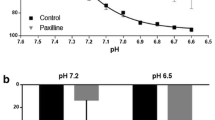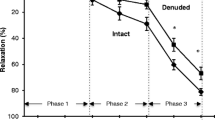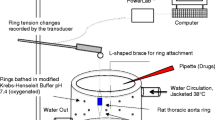Summary
The effects of the K+ channel opening drugs minoxidil sulphate and cromakalim, on 42K+ and 86Rb+ efflux and on vasorelaxation in rat isolated aorta, were compared. In rat aortic rings precontracted with noradrenaline (100 nmol/l), minoxidil sulphate and cromakalim concentration-dependently inhibited induced tension by up to 90%, with pD2 values of 7.35±0.1 and 7.17±0.1, respectively. Glibenclamide (300 nmol/l), produced 2200- and 19-fold rightward shifts in the concentration-relaxation curves to minoxidil sulphate and cromakalim, respectively, without an effect on the maximum relaxation.
Both minoxidil sulphate and cromakalim increased the efflux of 42K+ and 86Rb+ from aorta in a concentration-dependent manner, with midpoints in the µmol/l range; the maximum efflux induced by minoxidil sulphate being approximately one tenth of that induced by cromakalim. The ratio of stimulated 86Rb+/42K+ efflux increased from 0.22 to 0.48 with increasing cromakalim concentrations, but was approximately constant (≈0.39) when the minoxidil sulphate concentration was varied. In the presence of minoxidil sulphate, the effects of cromakalim on 42K+ and 86Rb+ efflux were inhibited in a concentration-dependent manner, by up to 60%. In the continuing presence of cromakalim (300 nmol/l), minoxidil sulphate (10 µmol/l)-induced increases in 42K+ and 86Rb+ efflux were inhibited by 45%, whereas conditioning with cromakalim (1 µmol/l) inhibited the 86Rb+ efflux stimulated by additional superfusion of cromakalim (1 µmol/l) by 85%. Glibenclamide inhibited minoxidil sulphate (10 µmol/l)- and cromakalim (1 µmol/l)-induced increases in 42K+ and 86Rb+ efflux in a concentration-dependent manner with IC50 values of approximately 80 nmol/l.
In conclusion, the efflux data suggest that considerable overlap exists between the channels opened by minoxidil sulphate and those opened by cromakalim in rat aorta. Minoxidil sulphate has a weak efficacy as a K+ channel opener, and may act to open a homogeneous population of K+ channels. In contrast, the actions of cromakalim (≥1 µmol/l) are associated with large increases in tracer efflux, which are probably mediated via a heterogeneous population of K+ channels. However, only a small proprtion of this induced efflux appears to be required for relaxation. The differential inhibition by glibenclamide of the vasorelaxant effects of minoxidil sulphate and cromakalim may result from (a) the partial agonist properties of minoxidil sulphate in opening K+ channels and/or (b) additional mechanisms of vasorelaxation, which differ in their sensitivity to glibenclamide.
Similar content being viewed by others
References
Ashcroft SJH, Ashcroft FM (1990) Properties and functions of ATP-sensitive K-channels. Cell Signal 2:197–213
Bray KM, Weston AH, Duty S, Newgreen DT, Longmore J, Edwards G, Brown TJ (1991) Differences between the effects of cromakalim and nifedipine on agonist-induced responses in rabbit aorta. Br J Pharmacol 102:337–344
Beech DJ, Bolton TB (1989) Properties of cromakalim-induced potassium conductance in smooth muscle cells isolated from the rabbit portal vein. Br J Pharmacol 98:851–864
Bevington PR (1969) Data reduction and error analysis for the physical sciences. McGraw-Hill, New York, pp 55–65, pp 92118
Bray KM, Quast U (1991) Tedisamil (KC 8857) differentially inhibits the 86Rb+ efflux-stimulating and vasorelaxant properties of cromakalim. Fur J Pharmacol (in press)
Bray KM, Weston AH (1989) Differential concentration-dependent effects of K-channel openers on 42K and 86Rb efflux in rabbit isolated aorta. Br J Pharmacol 98:885P
Cook NS, Quast U (1990) Potassium channel pharmacology. In: Cook NS (ed) Potassium channels, structure, classification, function and therapeutic potential. Ellis Horwood, Chichester, pp 181–255
Cheng Y-C, Prusoff WH (1973) Relationship between the inhibition constant (K1) and the concentration of inhibitor which causes 50% inhibition (IC50) of an enzymatic reaction. Biochem Pharmacol 22:3099–3108
Draper NR, Smith H (1981) Applied regression analysis. Wiley, New York, pp 85–96, pp 458–517
Fan Z, Nakayama K, Hiraoka M (1990) Multiple actions of pinacidil on adenosine triphosphate-sensitive potassium channels in guinea-pig ventricular myocytes. J Physiol 430:273–295
Gelband CH, Lodge NG, Talvenheimo JA, van Breemen C (1988) BRL34915 increases Popen of the large conductance Ca2+ activated K+ channel isolated from rabbit aorta in planar lipid bilayers. Biophys J 53:149a
Gelband CH, Silberberg SD, Groschner K, van Breemen C (1990) ATP inhibits smooth muscle Ca2+-activated K+-channels. Proc R Soc Lond B 242:23–28
Hamilton TC, Weston AH (1989) Cromakalim, nicorandil and pinacidil; novel drugs which open potassium channels in smooth muscle. Gen Pharmacol 20:1–9
Hamilton TC, Weir SW, Weston AH (1986) Comparison of the effects of BRL34915 and verapamil on electrical and mechanical activity in rat portal vein. Br J Pharmacol 88:103–111
Hu S, Kim HS, Okolie P, Weiss GB (1990) Alterations by glyburide of effects of BRL34915 and P1060 on contraction, 86Rb efflux and the maxi-K+ channel in rat portal vein. J Pharmacol Exp Ther 253:771–777
Johnson GA, Barsuhn KJ, McCall JM (1982) Sulfation of minoxidil by liver sulfotransferase. Biochem Pharmacol 31:2949–2954
Jones AW (1980) Content and fluxes of electrolytes. In: Bohr DF, Somlyo AP, Sparks HV Jr (eds) Handbook of physiology: The cardiovascular system, vol 11. Vascular smooth muscle. American Physiological Society, Washington, pp 253–299
Leblanc N, Wilde DW, Keef KD, Hume JR (1989) Electrophysiological mechanisms of minoxidil sulphate-induced vasodilatation of rabbit portal vein. Circ Res 65:1102–1111
Meisheri D, Cipkus LA, Taylor CJ (1988) Mechanism of action of minoxidil sulphate-induced vasodilatation: a role for increased K+ permeability. J Pharmacol Exp Ther 245:751–760
Morris JEJ, Taylor SG (1990) Effect of rubidium on relaxant agents in guinea-pig trachea. Br J Pharmacol 96:232P
Newgreen DT, Bray KM, McHarg AD, Weston AH, Duty S, Brown BS, Kay PB, Edwards G, Longmore J, Southerton JS (1990) The action of diazoxide and minoxidil sulphate on rat blood vessels: a comparison with cromakalim. Br J Pharmacol 100:605–613
Quast U (1987) Effect of the K+ efflux stimulating vasodilator BRL34915 on 86Rb+ efflux and spontaneous activity in guinea-pig portal vein. Br J Pharmacol 91:569–578
Quast U, Baumlin Y (1988) Comparison of the effluxes of 42K+ and 86Rb+ elicited by cromakalim (BRL34915) in tonic and phasic vascular tissue. Naunyn-Schmiedeberg's Arch Pharmacol 338:319–326
Quast U, Bray K (1991) Ba2+ and Rb+ as inhibitors of cromakalim's effects in rat aorta. Pflügers Arch 418:R50
Quast U, Cook NS (1989) Moving together: K+ channel openers and ATP-sensitive K+ channels. Trends Pharmacol Sci 10:431–435
Standen NB, Quayle JM, Davies NW, Brayden JE, Huang Y, Nelson MT (1989) Hyperpolarizing vasodilators activate ATP-sensitive K+ channels in arterial smooth muscle. Science 245:177–180
Author information
Authors and Affiliations
Additional information
Send offprint requests to U. Quasi at the above address
Rights and permissions
About this article
Cite this article
Bray, K., Quast, U. Some degree of overlap exists between the K+-channels opened by cromakalim and those opened by minoxidil sulphate in rat isolated aorta. Naunyn-Schmiedeberg's Arch Pharmacol 344, 351–359 (1991). https://doi.org/10.1007/BF00183011
Received:
Accepted:
Issue Date:
DOI: https://doi.org/10.1007/BF00183011




